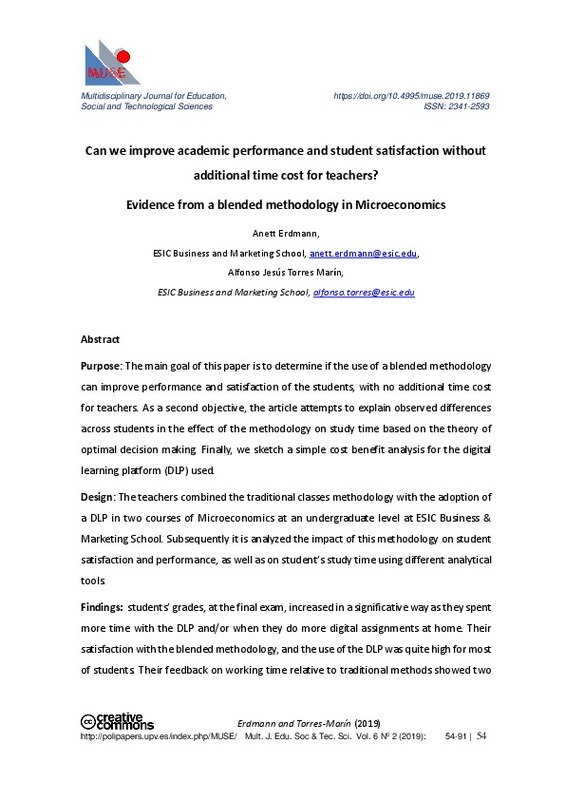Aguirre, A.C., Quintana H.P. & Miranda, R.T. (2015). Aplicación de las TIC en la educación superior como estrategia innovadora para el desarrollo de competencias digitales. Campus Virtuales, 3 (1), 88-101.
Ahmed, N., Ballard, A., Ohkubo, S., & Limaye, R. (2017). Global Health eLearning: Examining the effects of blended learning models on knowledge application and retention.
Alonso, L. E., Fernández, C. J., & Nyssen, J. M. (2009). El debate sobre las competencias. Una investigación cualitativa en torno a la educación superior y el mercado de trabajo en España. Madrid: ANECA.
[+]
Aguirre, A.C., Quintana H.P. & Miranda, R.T. (2015). Aplicación de las TIC en la educación superior como estrategia innovadora para el desarrollo de competencias digitales. Campus Virtuales, 3 (1), 88-101.
Ahmed, N., Ballard, A., Ohkubo, S., & Limaye, R. (2017). Global Health eLearning: Examining the effects of blended learning models on knowledge application and retention.
Alonso, L. E., Fernández, C. J., & Nyssen, J. M. (2009). El debate sobre las competencias. Una investigación cualitativa en torno a la educación superior y el mercado de trabajo en España. Madrid: ANECA.
Beard, L. H. (2017). 'Incentivised reading'-Using an online VLE to measure engagement and attainment in student learning. International Journal for Innovation Education and Research, 5(11), 74-86.
https://doi.org/10.21125/edulearn.2017.0006
Becker, W. E., & Greene, W. H. (2001). Teaching statistics and econometrics to undergraduates. Journal of Economic Perspectives, 15(4), 169-182.
https://doi.org/10.1257/jep.15.4.169
Bonk, C. J., & Graham, C. R. (2012). The handbook of blended learning: Global perspectives, local designs. John Wiley & Sons.
Bravo, L. E. C., Guerrero, K. G., & López, H. J. F. (2011). Uso de las TIC y especialmente del blended learning en la enseñanza universitaria. Revista Educación y desarrollo social, 5(1), 151-160.
Brown, M. G. (2016). Blended instructional practice: A review of the empirical literature on instructors' adoption and use of online tools in face-to-face teaching. The Internet and Higher Education, 31, 1-10.
https://doi.org/10.1016/j.iheduc.2016.05.001
Castro-Rodriguez, M., De Castro Calvo, A., & Hernandez Rivero, V. M. (2017). Analysis of Spanish commercial digital educational platforms for Primary Education. Revista Latinoamericana de Tecnologia Educativa-RELATEC, 16(2), 49-62.
Efimchik, E. A., Ivaniushin, D. A., Kopylov, D. S., & Lyamin, A. V. (2017). A Technique for Applying RLCP-Compatible Labs on Open edX Platform. In E-Learning, E-Education, and Online Training (pp. 12-18). Springer, Cham.
https://doi.org/10.1007/978-3-319-49625-2_2
Ericsson, K. A. (2002). Attaining excellence through deliberate practice: Insights from the study of expert performance.
Fernández March, A. (2005). Nuevas metodologías docentes. Valencia: Universidad Politécnica de Valencia, Valencia.
Gortner Lahmers, A., & Zulauf, C. R. (2000). Factors associated with academic time use and academic performance of college students: A recursive approach. Journal of College Student Development, 41, 544-556
Hattinger, M., Engeström, Y., & Sannino, A. (2018). From contradictions to transformation: a study of joint Work-Integrated Elearning between Industry and University. Journal of Engineering Education.
Hinerasky, C., Fahr, R., & Sliwka, D. (2017). Learning outcomes, feedback, and the performance effects of a training program. Universitätsbibliothek.
Lisitsyna, L. S., Efimchik, E. A., & Izgareva, S. A. (2017, June). RLCP-compatible Virtual Laboratories with 3d-models and Demonstration Mode: Development and Application in e-learning. In International Conference on Smart Education and Smart E-Learning (pp. 75-81). Springer, Cham. https://doi.org/10.1007/978-3-319-59451-4_8
Liu, Y., & Xie, T. (2019). Machine learning versus econometrics: prediction of box office. Applied Economics Letters, 26(2), 124-130. https://doi.org/10.1080/13504851.2018.1441499
Medina, J. M. C., Medina, I. I. S., & Rojas, F. R. (2016). Uso de objetos virtuales de aprendizaje ovas como estrategia de enseñanza-aprendizaje inclusivo y complementario a los cursos teóricos-prácticos. Revista educación en ingeniería, 11(22), 4-12.
Miríadax (2018, 3 de mayo). Nuestros números. Recuperado de https://miriadax.net/web/guest/nuestros-numeros
Moodle.org. (2018, 3 de mayo). Course and content. Recuperado de https://moodle.net/stats/
Mosbeck, M., Markum, G., Platschek, A. & Jantsch, A. (2018). E-Learning System for Automatic Generation and Evaluation of Per-Student Customized Tasks for Hardware Modeling Courses, World Academy of Science, Engineering and Technology, International Jour. https://doi.org/10.1109/NORCHIP.2018.8573455
Sangrá, L. M. (2016). La nueva brecha digital. El futuro de las nuevas tecnologías en Primaria desde la formación del profesorado. Revista electrónica interuniversitaria de formación del profesorado, 19(2), 301-313.
Pérez, P., Urbano, J. & Onías, A. (2017). Los recursos didácticos digitales en la calidad del aprendizaje significativo en el área de matemáticas, (Bachelor's thesis, Universidad de Guayaquil).
Plant, E. A., Ericsson, K. A., Hill, L., & Asberg, K. (2005). Why study time does not predict grade point average across college students: Implications of deliberate practice for academic performance. Contemporary Educational Psychology, 30(1), 96-116. https://doi.org/10.1016/j.cedpsych.2004.06.001
Rodríguez Miranda, F. D. P. (2009). Los coordinadores y coordinadoras de Centros TIC: su importancia como asesores internos para la calidad y el desarrollo del currículo en la Educación Primaria de Andalucía.
The Core Team (2017). The Economy: Economics for a changing world. Oxford University Press. Recuperado de http://www.core-econ.org/the-economy/index.html
Tornero J.M. & Pi, M. (2013). La integración de las TIC y los libros digitales en la educación. España: Grupo Planeta.
Torres, A.T., Gonzalez E. y Bordonado, J. (2018, 2-4, July). Using a digital interactive labs educator tool to improve the scoring and learnig results of marketing students of econometric in ESIC Business & Marketing School. 10th International Conference on Education and New Learning Technologies. Palma Spain. ISBN: 978-84-09-02709-5. Doi: 10.21125.
[-]








